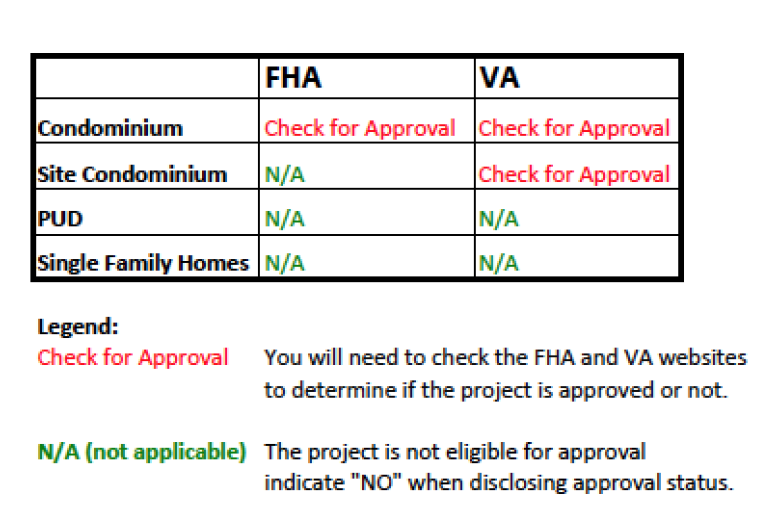- Home
- How to Meet CA AB-596 Budget Requirements
As of July 1, 2016, Civil Code Section 5300 requires condominium Associations to disclose the current FHA and VA Certification status in the annual Budget disclosures. The statements must be in at least 10-point font on 2 separate pieces of paper.
The purpose: AB 596 was created to notify all owners, lenders, realtors, and prospective buyers of the current FHA and VA Certification status. The writers of the bill also want to publicize the benefits of being FHA and/or VA certified.
What the managers need to do: Managers will need to include the new policy statements in ALL Condominium Association budget disclosures, including site condominiums. Some Legal opinions recommend including the policy statements in ALL attached PUD budget disclosures as well.
Step1: Identify the type of Unit: Is the project a Condominium, Site Condo, or PUD?
- Determining if your Association is a Condominium, PUD, or Site Condominium is the first step. This can be done by looking at the CCR’s or Declarations.
- Condominiums: If your community is under a Condominium form of ownership, the CC&Rs or Declarations will state this. In addition, condominiums have “Condo Plans” which are referred to in the Governing Documents. If you see any reference to Condo Plans in the declarations, you can be sure it’s a condominium. Keep in mind, Townhomes, Townhouses, Villas, Bungalows, Garden Homes etc. are a “style” of unit, not a legal description. These types of units will either be a Condo, PUD, Site Condo or Single Family Home (SFR). Condominiums will qualify for both FHA and VA approval.
- Site Condominium: If your project is under a Condominium form of Ownership, but meet ALL of the following criteria, it is considered a “Site Condo” Site condominiums qualify for VA approval, but do not need FHA approval.
- Single-family totally detached dwellings (no shared garages or any other attached buildings or e.g. archways, breezeways); and
- Are encumbered by a declaration of condominium covenants or condominium form of ownership; and
- The condominium unit consists of the entire structure as well as the site and air space and are not considered to be common areas or limited common areas; and
- Insurance and maintenance costs are totally the responsibility of the unit owner; and
- Any common assessments collected will be for amenities outside of the footprint of the individual site.
- PUD: If you do not see the word “Condominium” or any reference to Condo Plans, the Project is most likely a PUD. In a Planned Unit Development, the unit owner may own the land, walls, or other structural elements making up the unit. PUDs do not need FHA or VA Approval.
- Single Family Homes: Single Family homes are stand-alone residences. They are not connected to other homes or units, and they occupy their own lot. Single Family Residences do not need FHA or VA approval.
Step 2: Does My Project Need FHA or VA Certification?
- Once you’ve determined the legal description of your Association, you can discern if FHA or VA Condo Certification is applicable. See the chart below.

Step 3: The Disclosure
- FHA
- Once the Legal unit type and Approval Status are determined, you are ready to disclose. On a Separate page within your Budget Disclosure, using at least 10-Point font, you must insert the following statement:
- “Certification by the Federal Housing Administration may provide benefits to members of an association, including an improvement in an owner’s ability to refinance a mortgage or obtain secondary financing and an increase in the pool of potential buyers of the separate interest.
- This common interest development [is/is not (circle one)] a condominium project.
- The association of this common interest development [is/is not (circle one)] certified by the Federal Housing Administration.”
- Once the Legal unit type and Approval Status are determined, you are ready to disclose. On a Separate page within your Budget Disclosure, using at least 10-Point font, you must insert the following statement:
- VA
- On a second separate page within your Budget Disclosure, using at least 10-Point font, you must insert the following statement:
-
“Certification by the federal Department of Veterans Affairs may provide benefits to members of an association, including an improvement in an owner’s ability to refinance a mortgage or obtain secondary financing and an increase in the pool of potential buyers of the separate interest.
-
This common interest development [is/is not (circle one)] a condominium project.
-
The association of this common interest development [is/is not (circle one)] certified by the federal Department of Veterans Affairs.”
-
- On a second separate page within your Budget Disclosure, using at least 10-Point font, you must insert the following statement:
